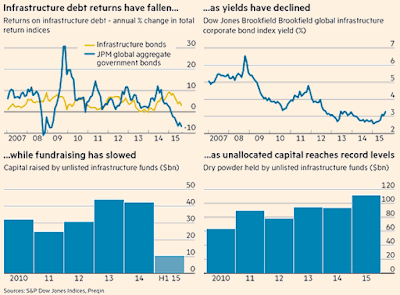Infrastructure projects, with their long-term revenue streams, are an attractive investment proposition for long-term capital providers like pension funds and insurers. The attraction is amplified when other long-term investment alternatives become scarce and the pipeline of less riskier infrastructure projects dries up. The long period of monetary accommodation has dramatically compressed asset yields and public debts and economic weakness has squeezed infrastructure investments. The FT writes,
Yields on the Dow Jones Brookfield global infrastructure corporate bond index have fallen steadily over the past seven years, from a high of 6.5 per cent in October 2008 to 3.3 per cent at the end of August... The pressure on infrastructure pricing is unlikely to subside in the near term, with 154 dedicated infrastructure funds currently fundraising for a combined sum of $99bn, according to Preqin... investors are not just looking for an illiquidity premium [better returns] from infrastructure assets but are seeking access to a diverse set of companies whose bonds offer better inflation protection than unsecured corporate bonds.
Michael Wilkins, an infrastructure specialist at Standard & Poor’s says, “The pipeline of deals is very scarce and there is a lack of sufficient opportunities for institutional investors to deploy their capital. There is intense competition in brownfield [existing] projects, where anything decent just gets snapped up”... the record amount of “dry powder” [unallocated capital], which has risen 20 per cent so far this year, to a record $112bn, is a concern. Problems are emerging due to the sheer weight of capital chasing infrastructure assets. As a result some investors are now paying “top dollar” for assets that have a significantly higher risk profile, such as wind farms in Finland. Here equity yields have dropped from 10 per cent to 6 per cent over the past 12 months.Towers Watson says some of the biggest opportunities for institutional investors are in funding government-supported projects in economies where financing from public budgets remains constrained... it is vital that governments provide sufficient incentives to encourage institutional investors to help address infrastructure funding gaps. But this will require fresh thinking about regulatory frameworks and how risks are transferred between the public and private sectors.
The infrastructure financing opportunity from such institutional foreign capital, for countries like India are undeniable. But as I have blogged earlier, the pool of investible 'dry powder' available for countries like India may not be as much as being made out. In a country with a history of high inflation and exchange rate volatility, and resultant high-equity risk premiums (and these are not going to change much with small cyclical downturns in inflation), the returns from infrastructure considered attractive enough for foreign debt funds remains very high, atleast 300-500 basis points higher than in developed economy markets.
In the circumstances, large new projects, with the considerable (un-mitigatable!) uncertainty associated with greenfield projects, are unlikely to catch the attention of these funds. Only brownfield projects, with established and commercially viable enough cash-flows, are likely to be attractive enough for these investors. And, such projects are likely to be irresistibly attractive, and will continue to be for the foreseeable future.
Unfortunately, there are too few such projects in the Indian market. It underlines the need for large scale public investment driven infrastructure push, where governments can, at arms-length, finance and construct public infrastructure projects, off-load construction risks, establish commercial viability, and then concession and/or exit its equity stake. At the least, public finance should be made available to ensure commercial viability of PPP projects. Roads, railways, urban mass transit, power transmission, upstream water and sewerage infrastructure, and even affordable low-income housing, are potential areas for such public investments followed by exiting to various categories of infrastructure funds.

No comments:
Post a Comment